Quick Look
Grade Level: 4 (4-5)
Time Required: 45 minutes
Expendable Cost/Group: US $0.00 This activity uses some non-expendable (reusable) items, such as LEGO MINDSTORMS robots and software; see the Materials List for details.
Group Size: 3
Activity Dependency: None
Subject Areas: Measurement, Physics, Science and Technology
NGSS Performance Expectations:

| 3-5-ETS1-3 |
| 4-PS3-4 |
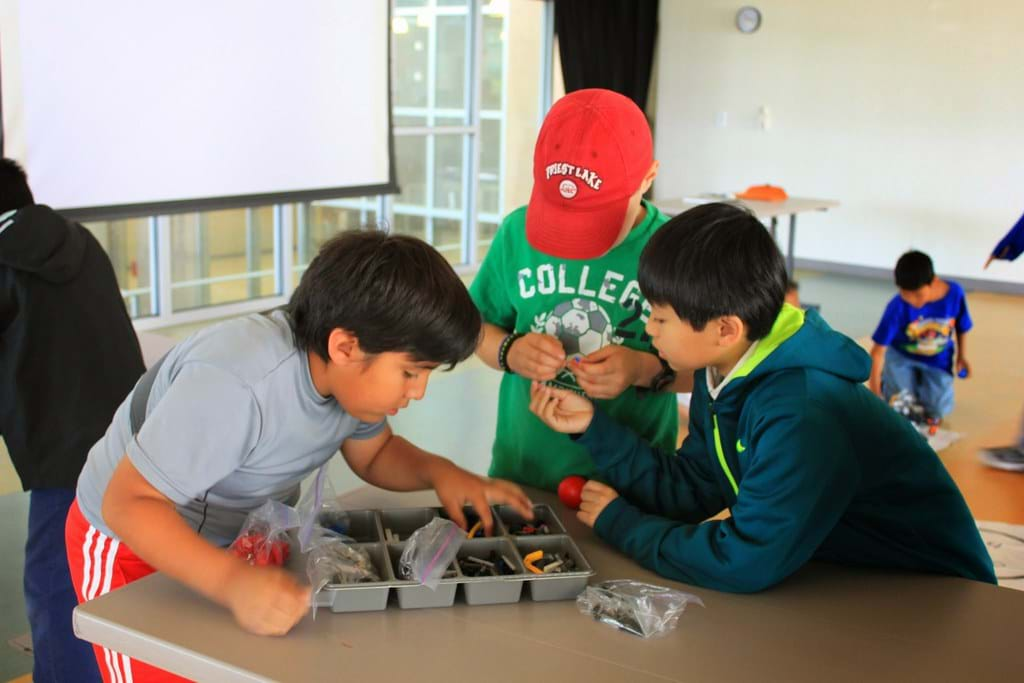
Summary
Working in teams of three, students perform quantitative observational experiments on the motion of LEGO® MINDSTORMS® robotic vehicles powered by the stored potential energy of rubber bands. They experiment with different vehicle modifications (such as wheel type, payload, rubber band type and lubrication) and monitor the effects on vehicle performance. The main point of the activity, however, is for students to understand that through the manipulation of mechanics, a rubber band can be used in a rather non-traditional configuration to power a vehicle. In addition, this activity reinforces the idea that elastic energy can be stored as potential energy.Engineering Connection
Mechanical engineering applications—such as wind turbines, electric stoves and television screens—typically require the manipulation and transference of energy. This activity provides students with an example of the application of the elastic energy of a rubber band to a non-ideal mechanical setup, mimicking real-world challenges to design efficient engines with aerodynamic designs. Students test designs and tabulate observations based on varied experimental parameters.
Learning Objectives
After this activity, students should be able to:
- Test the effects of altering the number of turns of a rubber band on the motion of a model vehicle, reinforced with quantitative results.
- Test the effectiveness of varying one or more of the following on vehicle motion: wheel type, payload weight, rubber band type and lubrication.
- Report on the conclusions and collaborate with other groups to optimize vehicle parameters.
Educational Standards
Each TeachEngineering lesson or activity is correlated to one or more K-12 science,
technology, engineering or math (STEM) educational standards.
All 100,000+ K-12 STEM standards covered in TeachEngineering are collected, maintained and packaged by the Achievement Standards Network (ASN),
a project of D2L (www.achievementstandards.org).
In the ASN, standards are hierarchically structured: first by source; e.g., by state; within source by type; e.g., science or mathematics;
within type by subtype, then by grade, etc.
Each TeachEngineering lesson or activity is correlated to one or more K-12 science, technology, engineering or math (STEM) educational standards.
All 100,000+ K-12 STEM standards covered in TeachEngineering are collected, maintained and packaged by the Achievement Standards Network (ASN), a project of D2L (www.achievementstandards.org).
In the ASN, standards are hierarchically structured: first by source; e.g., by state; within source by type; e.g., science or mathematics; within type by subtype, then by grade, etc.
NGSS: Next Generation Science Standards - Science
| NGSS Performance Expectation | ||
|---|---|---|
|
3-5-ETS1-3. Plan and carry out fair tests in which variables are controlled and failure points are considered to identify aspects of a model or prototype that can be improved. (Grades 3 - 5) Do you agree with this alignment? |
||
| Click to view other curriculum aligned to this Performance Expectation | ||
| This activity focuses on the following Three Dimensional Learning aspects of NGSS: | ||
| Science & Engineering Practices | Disciplinary Core Ideas | Crosscutting Concepts |
| Plan and conduct an investigation collaboratively to produce data to serve as the basis for evidence, using fair tests in which variables are controlled and the number of trials considered. Alignment agreement: | Tests are often designed to identify failure points or difficulties, which suggest the elements of the design that need to be improved. Alignment agreement: Different solutions need to be tested in order to determine which of them best solves the problem, given the criteria and the constraints.Alignment agreement: | |
| NGSS Performance Expectation | ||
|---|---|---|
|
4-PS3-4. Apply scientific ideas to design, test, and refine a device that converts energy from one form to another. (Grade 4) Do you agree with this alignment? |
||
| Click to view other curriculum aligned to this Performance Expectation | ||
| This activity focuses on the following Three Dimensional Learning aspects of NGSS: | ||
| Science & Engineering Practices | Disciplinary Core Ideas | Crosscutting Concepts |
| Apply scientific ideas to solve design problems. Alignment agreement: | Energy can also be transferred from place to place by electric currents, which can then be used locally to produce motion, sound, heat, or light. The currents may have been produced to begin with by transforming the energy of motion into electrical energy. Alignment agreement: The expression "produce energy" typically refers to the conversion of stored energy into a desired form for practical use.Alignment agreement: Possible solutions to a problem are limited by available materials and resources (constraints). The success of a designed solution is determined by considering the desired features of a solution (criteria). Different proposals for solutions can be compared on the basis of how well each one meets the specified criteria for success or how well each takes the constraints into account.Alignment agreement: | Energy can be transferred in various ways and between objects. Alignment agreement: Engineers improve existing technologies or develop new ones.Alignment agreement: Most scientists and engineers work in teams.Alignment agreement: Science affects everyday life.Alignment agreement: |
Common Core State Standards - Math
-
Represent and interpret data.
(Grade
4)
More Details
Do you agree with this alignment?
International Technology and Engineering Educators Association - Technology
-
Students will develop an understanding of the attributes of design.
(Grades
K -
12)
More Details
Do you agree with this alignment?
-
Students will develop an understanding of engineering design.
(Grades
K -
12)
More Details
Do you agree with this alignment?
State Standards
New York - Math
-
Represent and interpret data.
(Grade
4)
More Details
Do you agree with this alignment?
New York - Science
-
Plan and carry out fair tests in which variables are controlled and failure points are considered to identify aspects of a model or prototype that can be improved.
(Grades
3 -
5)
More Details
Do you agree with this alignment?
-
Apply scientific ideas to design, test, and refine a device that converts energy from one form to another.
(Grade
4)
More Details
Do you agree with this alignment?
Materials List
Each group needs:
- LEGO MINDSTORMS EV3 robot, such as EV3 Core Set (5003400) at https://education.lego.com/en-us/products/lego-mindstorms-education-EV3-core-set-/5003400
- LEGO MINDSTORMS Education EV3 Software 1.2.1, free online, you have to register a LEGO account first at https://www.lego.com/en-us/mindstorms/downloads/download-software
- computer, loaded with EV3 1.2.1 software
- 1 rubber band (3-inch diameter)
- 1 rubber band vehicle, pre-built for each group (refer to the Vehicle Building Instructions)
- stopwatch or timer
- Data Collection Worksheet, one per student
- Vehicle Building Instructions
- (optional) talcum powder
Alternative: LEGO MINDSTORMS NXT Set:
Note: This activity can also be conducted with the older (and no longer sold) LEGO MINDSTORMS NXT set instead of EV3; see below for those supplies:
- LEGO MINDSTORMS NXT robot, such as the NXT Base Set
- LEGO MINDSTORMS Education NXT Software 2.1
- computer, loaded with NXT 2.1 software
Worksheets and Attachments
Visit [www.teachengineering.org/activities/view/nyu_carpotential_activity1] to print or download.Introduction/Motivation
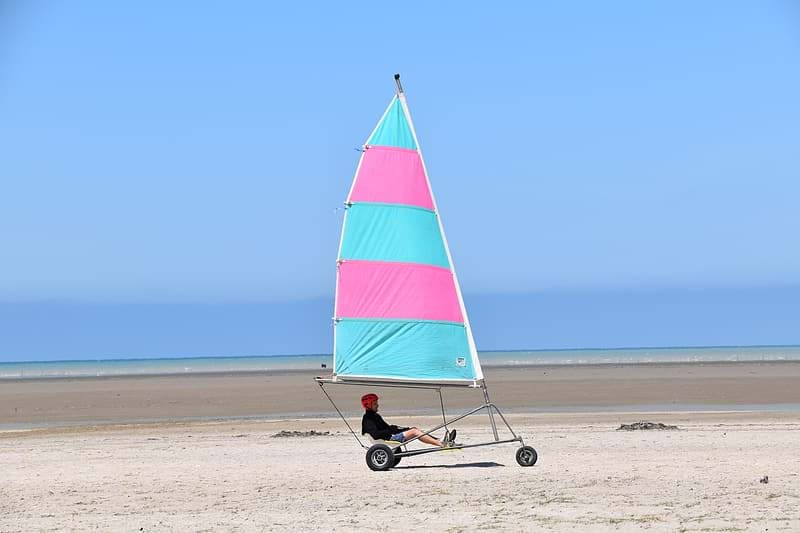
Scientists and engineers rely on energy storage and conversion to make their devices work. For example, solar panels convert the sun's light into electricity. Using natural gasoline is an example of the conversion of chemical energy to mechanical energy in order to power vehicles to get people to the places they want to go. When rubber bands are stretched, the mechanical energy used to make the rubber band longer is converted to elastic potential energy in the rubber band. This energy is released when the rubber band is no longer stretched, or allowed to relax. This activity demonstrates the conversion of rubber's potential energy into mechanical motion with a simple LEGO model car.
This neat trick is no magic, but rather the mechanical engineer's ability to convert energy. Today, you learn how to convert such energy.
Procedure
Background
Energy conversions are happening around us every day. Begin the activity by introducing common examples of the different types of energy; such as kinetic, potential, electrical, thermal, elastic, etc. For example, an electric heater converts electrical energy to thermal energy. A roller coaster car that starts at rest and drops converts potential energy to kinetic energy. An electrical stove is an example of the conversion from electrical to thermal energy. An electric car is an example of the conversion of electrical energy to kinetic energy. Many other different devices convert energy to work, such as computers, trains, space ships and electronic music players. Finally, an example of the conversion of elastic energy to kinetic energy is the use of a rubber band as the source.
A rubber band stores its energy by increasing its elastic potential energy when stretched or twisted (see Figure 4 to notice that when the gears are turned, the rubber is twisted, increasing the potential energy in the car). When the car releases, the potential energy is converted into motion, and you see the car move forward. To repeat the car movement, all you have to do is retwist the rubber band.
Before the Activity
- Gather materials and make copies of the Data Collection Worksheet.
- Construct a LEGO rubber band model car for each group, following the Vehicle Building Instructions.
- For each model car, make sure that the wheels are able to wind up the rubber band and that the potential energy is properly and fully released. It may help to lightly coat the rubber band in talcum powder to keep it from not sticking to itself upon winding.
With the Students
A teacher-guided experiment whereby students change their model car designs.
- Inform students on the theory of the rubber band vehicle and its operation, as follows: "In a LEGO car, the elastic rubber band is the 'fuel' for the car. To pump 'fuel' into the car, you twist the rubber band, which adds elastic potential energy to the car's movement capability. When you release the car, the energy is converted to kinetic energy, making the car move forward."
- Let students to experiment with the operation of the vehicle on the floor or at their desks, as shown in Figure 1.
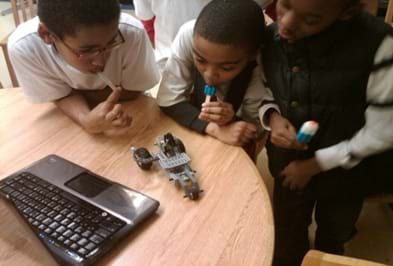
Figure 1. Students test their LEGO vehicle prior to starting the experiments. - With students, compare the rubber band to a car's engine. For example, with more gasoline (chemical energy), a regular car goes farther (mechanical energy). Similarly, with a rubber band tightly twisted (elastic potential energy), the LEGO car can go farther (mechanical energy). Given the same amount of gasoline, a real car with better engine efficiency than its counterpart goes farther. Similarly, given the same number of twists, a LEGO car with a good design goes farther than a car with a poor design.
- Direct students to test the effect of changing their cars' designs by changing variables (shape, axle length, car length, wheel placement, etc.). See Figures 2 and 3 for a modified vehicle design. Mention that in life, engineers consider tradeoffs in designing cars. For example, suburban/passenger vans require more supporting material. More material means more weight and, on average, results in slower cars. While testing, suggest that students to use meter sticks or tape measures to evaluate the distance that their modified vehicles travel.
- Tell students to be sure to twist their rubber bands the same amount every time so this becomes a valid measurement of the distance the car travels and an indicator of the car's performance.
- Give students ideas for modifications:
- altered wheel configurations (Figure 2)
- lubrication (talcum powder) coating on the rubber band
- different types of rubber bands (engine)
- additional payload (Figure 3)
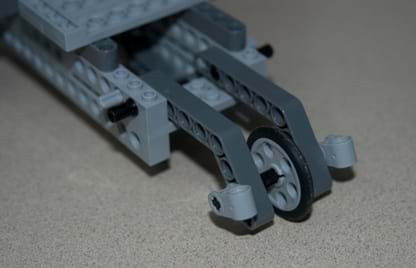
Figure 2. Wheel configuration is one design variable that students may change to test its effect on vehicle performance. 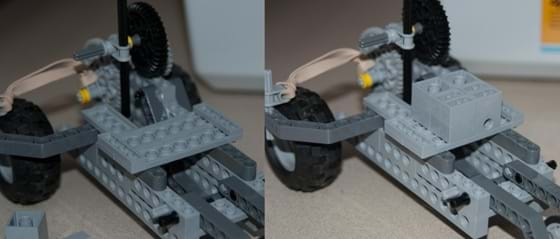
Figure 3. An example of how to alter a vehicle to accommodate payload by the addition of LEGO bricks (right). This is expected to ultimately affect the distance travelled by the car.
- Remind students to consider the potential energy meter that is built into the vehicle when designing experiments. The potential meter indicates that more elastic potential energy exists in the car with more twists in the rubber band, as illustrated in Figure 4. Ideally, carry out each experiment under the same conditions (that is, the same potential energy or same number of rubber band twists). Students can use the meter to ensure that the rubber band is wound approximately the same number of times every time they conduct a test comparing car designs.
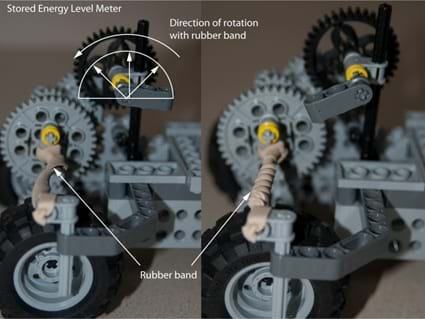
Figure 4. Using the potential energy meter to verify rubber band turns are the same during vehicle redesign tests. - Tabulate the results of group test iterations and incorporate the findings from all groups into an "optimized" car to determine if the distance traveled by the vehicle is enhanced. For example, if students are familiar with gear ratios, the distance of the car can be compared against the gear ratio of the car design. Alternatively, students can compare the distance traveled of their car against the weight of the car. Encourage the groups to work with other groups to collectively optimize the vehicles performance based on their collected data.
- As a class, discuss why certain modifications worked and others did not. Pick out keywords from the discussion and write them on the classroom board. Ask students to summarize the key findings from the optimized vehicles into paragraphs. After a few minutes, have a few students read their summary paragraphs to the class.
Vocabulary/Definitions
electrical energy: Energy from electricity.
kinetic energy: Energy from the motion of an object.
potential energy: Stored energy within an object.
thermal energy: Energy from a heat source.
Assessment
Pre-Activity Embedded Assessment
Prediction: Ask students to consider modern cars with respect to variables such as wheel type, lubrication, tires and engine. Ask students how they think changing these variables may improve or hinder a vehicle's performance. Ask them if they can think of other variables that can be changed. Discuss as a class.
Activity Embedded Assessment
Energy Storage Demonstration: Ask students to consider modern cars and what happens when you push the engine too far. Ask students to share their thoughts with the class. Then, in similar fashion, wind the rubber band car up until the point of failure. Ensure that the students witness the structural failures that ensue, reinforcing the point of energy storage limits of certain mechanical designs.
Ask students, what are the effects of altering the number of turns? How do changes in the designs of their cars affect the vehicles' motions? Restate the importance of experimental consistency and how this is established between sequential trials using the on-board potential energy gauge. Scientific experiments need to be repeatable, which is a guiding principle of the scientific method.
Post-Activity Assessment
Modification Keyword Summary: As a class, discuss why certain modifications worked and others did not. Pick out keywords from the discussion and write them on the classroom board. Ask students to summarize the key findings from the optimized vehicles into paragraphs. After a few minutes, have a few students read their summary paragraphs to the class. Compare student observations to gauge their depth of understanding of potential energy.
Graphing: As a class, graph the distance traveled at the different gear ratios for all the groups.
Troubleshooting Tips
Lightly coating the rubber band in talcum powder helps it not stick to itself upon winding.
Subscribe
Get the inside scoop on all things TeachEngineering such as new site features, curriculum updates, video releases, and more by signing up for our newsletter!More Curriculum Like This

Students make sense of how potential energy (stored energy) can be converted into kinetic energy (motion). Acting as if they were engineers designing vehicles, they use rubber bands, pencils and spools to explore how elastic potential energy from twisted rubber bands can roll the spools. They brains...

Students design, build and evaluate a spring-powered mouse trap racer. For evaluation, teams equip their racers with an intelligent brick from a LEGO© MINDSTORMS© EV3 Education Core Set and a HiTechnic© acceleration sensor.

Students get introduced to the real-world technical tool of a wind turbine propeller attachment. It’s a device that efficiently harvests wind energy, and in this activity they’ll build one of their own using a LEGO wind turbine, fan, and energy meter.

Students explore the basic characteristics of polymers through the introduction of two polymer categories: thermoplastics and thermosets. During teacher demos, students observe the unique behaviors of thermoplastics.
Copyright
© 2013 by Regents of the University of Colorado; original © 2010 Polytechnic Institute of New York UniversityContributors
Carlo Yuvienco, Paul PhamduySupporting Program
AMPS GK-12 Program, Polytechnic Institute of New York UniversityAcknowledgements
This activity was developed by the Applying Mechatronics to Promote Science (AMPS) Program funded by National Science Foundation GK-12 grant no. 0741714. However, these contents do not necessarily represent the policies of the National Science Foundation, and you should not assume endorsement by the federal government.
Last modified: October 16, 2020










User Comments & Tips